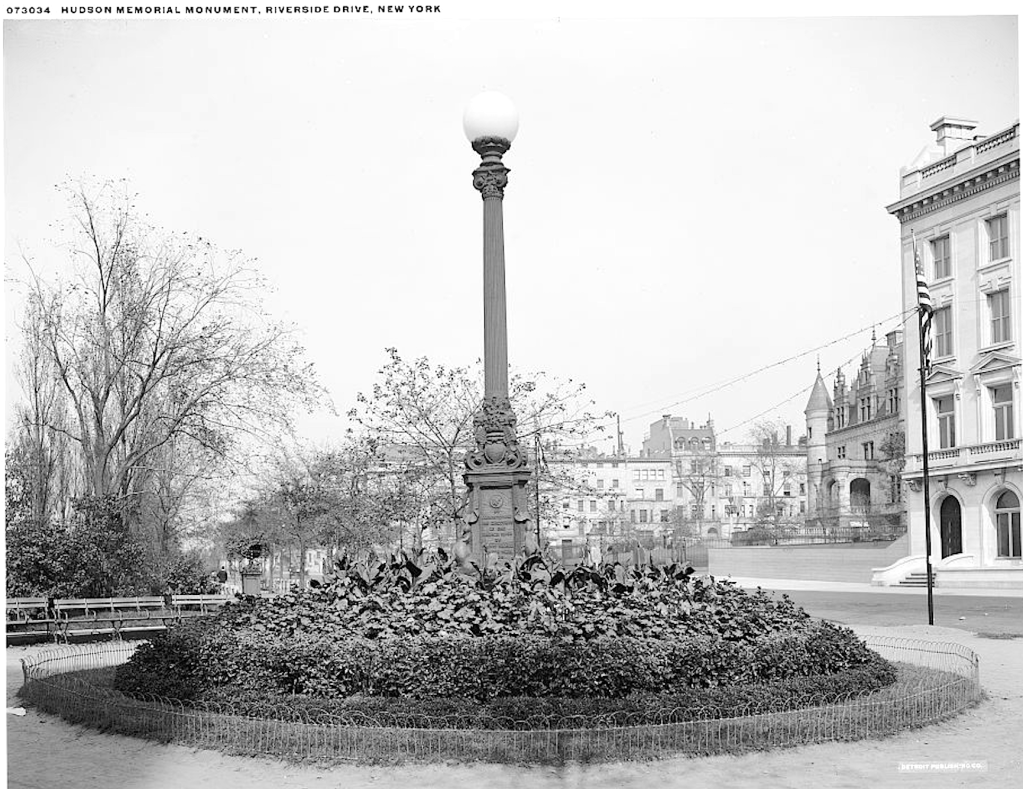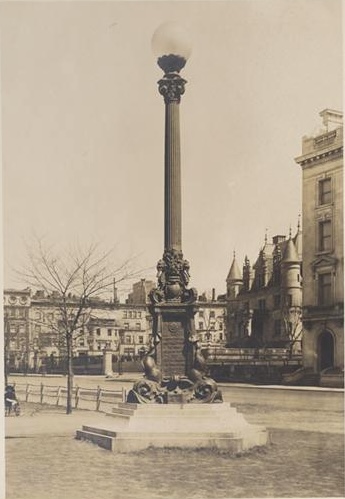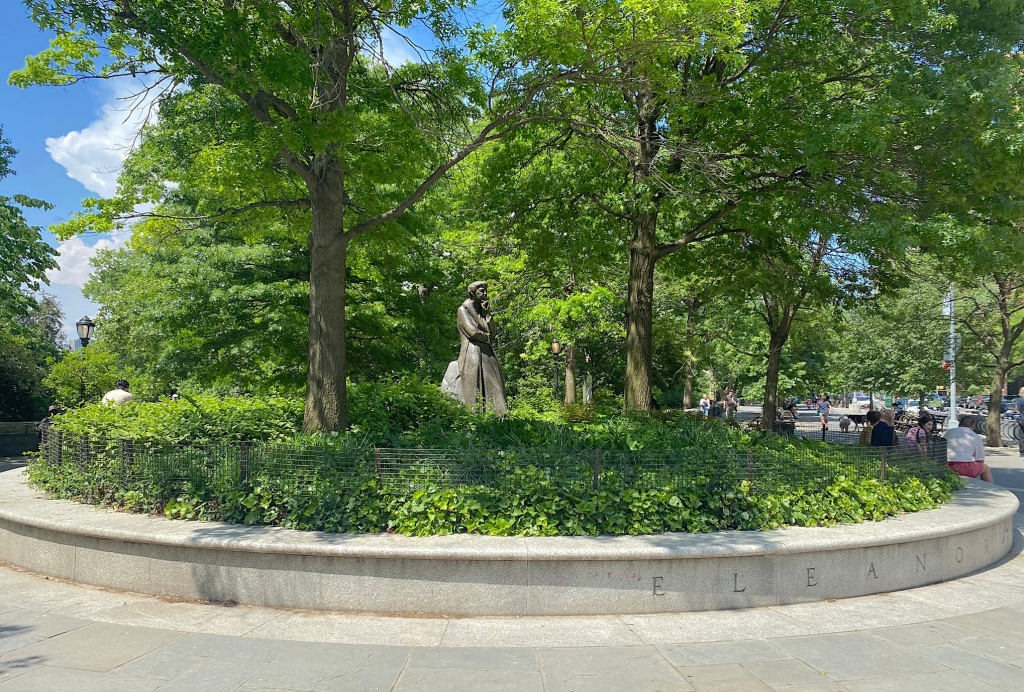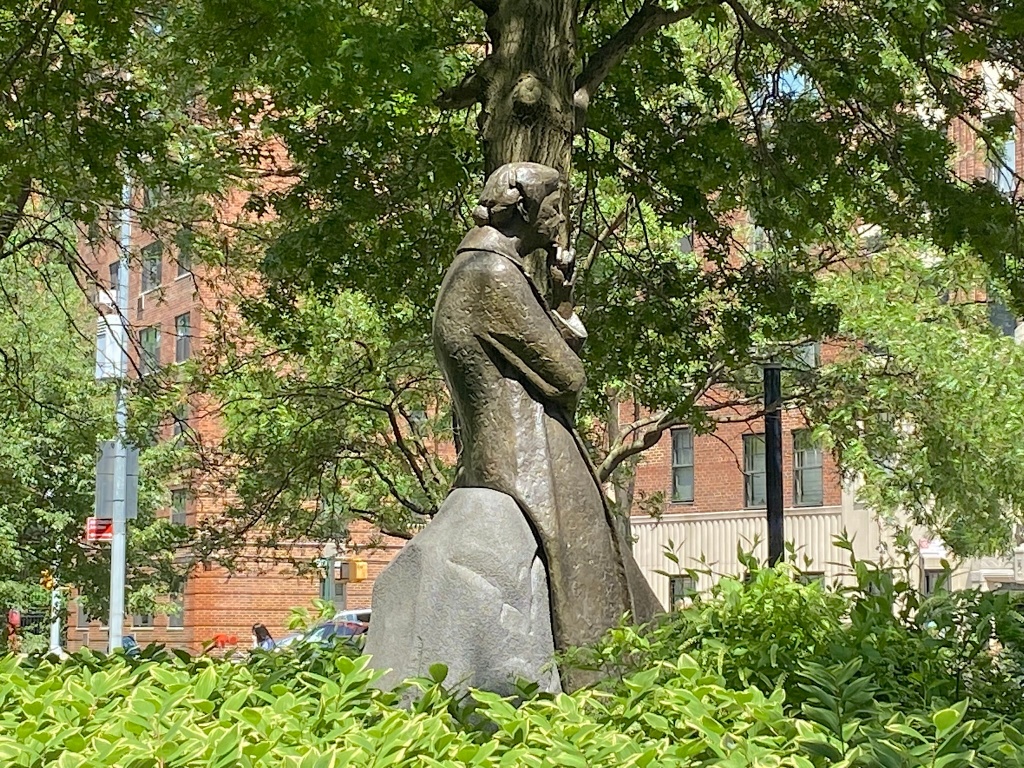It looked like an elegant streetlight: a slender pole of bronze standing on a granite base 18 feet high over a circular sitting area that’s part of Riverside Park.
Planted into a bed of flowers and shrubbery at 72nd Street and the beginning of Riverside Drive, the globe-topped monument consisted of inscriptions and bas reliefs inspired by Henry Hudson, whose namesake river ran just to the west.
You won’t find the monument there anymore; it’s long since been carted away.
So how did a memorial to Henry Hudson end up on Riverside Drive, opposite the Drive’s row house mansions and free-standing palaces, including the 75-room, Chateau-like Schwab Mansion (at right)—and why was this remnant of early 1900s Gotham removed?
The idea for the Hudson monument goes back to the turn of the century city. That’s when New York began planning the Hudson-Fulton celebration—a massive two-week event commemorating the 300th anniversary of Henry Hudson’s exploration of the river that bears his name, as well as the 100th anniversary of Robert Fulton’s Clermont paddlewheel steamboat.
The celebration would run from September 25 to October 9, 1909. Festivities in the works were unlike anything the city had ever seen, at least since the Washington Centennial in 1889.
To honor these maritime pioneers, officials scheduled a (above) flotilla of naval ships (with replicas of the Clermont and Hudson’s Half-Moon), fireworks, two parades, signal fires from Governor’s Island to Spuyten Duyvil, and the nighttime lighting of bridges, statues, and city buildings with thousands of incandescent bulbs.
Amid the excitement of all these plans, the Colonial Dames of America decided to build the bronze monument to Hudson. It was unveiled on September 29, 1909, in then middle of the Hudson-Fulton Celebration, to a crowd of Americans and Dutch dignitaries.
“There was a great fanfare of trumpets, a little woman in a pongee suit pulled a cord and ran from under, the Stars and Stripes came down, the Dutch colors followed, and the tall bronze and granite shaft . . . stood revealed,” wrote the New-York Tribune.
For the next five decades, the Hudson Memorial remained on Riverside Drive. And it might be there today if it wasn’t “toppled by a truck in the 1950s” as NYC Parks put it.
Evidently it was too damaged to repair, or perhaps the popularity of the monument had run its course—especially in a city that honored Hudson with an eponymous river, a northern Manhattan bridge, and a parkway.
But there is a memorial at this circular spot once again: a sculpture of Eleanor Roosevelt. Dedicated in 1996, “this piece depicts Roosevelt in heroic scale half-seated against a boulder with her hand on her chin in contemplation,” notes NYC Parks.
Surrounded again by greenery, the circle is a gathering spot for strollers and loungers. Instead of the magnificent Schwab mansion, the memorial stands in the shadow of Schwab House, the red-brick co-op that replaced the chateau in 1950.
It’s a fitting tribute to a New York City-born First Lady, and like the sculpture of Joan of Arc 21 blocks north at Riverside Drive and 93rd Street, it’s one of the few statues in a city park that honors a woman who actually lived—not a mythological or fictional female.
Riverside Drive is lined with fascinating memorials from the early 1900s, from recognizable figures like Joan of Arc to dramatic monuments honoring fallen firefighters and Civil War veterans. Find out their backstories by signing up for Ephemeral New York’s Riverside Drive Mansions & Monuments walking tour. Sunday, June 16 still has openings—click here for more info!
[Top image: LOC, 1910; second image, 1912: MCNY, X2010.11.3083; third image, 1909: MCNY, F2011.33.560]
Tags: Eleanor Roosevelt in New York City, Eleanor Roosevelt Memorial Riverside Drive, Henry Hudson Monument Riverside Drive, Henry Hudson Riverside Drive 72nd Street, Historic Monuments Riverside Drive, Hudson-Fulton Celebration New York City, Monuments of Riverside Drive NYC





May 27, 2024 at 3:32 am |
Interestingly, somehow the 400th anniversary of Giovanni da Verrazzano arriving here was completely ignored. He was the first to explore the east coast of the current United States of America. On April 17, 1524 he reached the New York Bay. Unbelievable how people are stuck in the present. Thank God we have Ephemeral New York to help preserve the past!!!
May 27, 2024 at 4:07 am |
Thank you! We’ll see if people come out for the 400th anniversary of the establishment of New Amsterdam, to be celebrated next year. Meanwhile aside from his eponymous bridge, Verrazano continues to be mostly forgotten.
May 27, 2024 at 6:50 am |
Verrazzano sailed for King Francois I of France. The purpose of Verrazzano’s voyages, like Columbus’, was to find a route to Asia. So all of those inlets, bays and coves he checked out—including the Narrows that bear his name—were explored in the hope of finding that passage to the Orient that Europeans believed to exist.
Verrazzano’s first voyage took him along the East Coast from what we now call Florida to Newfoundland. He, apparently, only explored any place—including New York Bay and Narragansett—long enough to see that they didn’t lead to the Pacific. His later voyages for the French crown, to the Caribbean and South America, had the same goal.
I think Verrazzano isn’t as well-remembered as Hudson or Columbus because his explorations didn’t lead to the establishment of colonies. If it had, not only would many more things be named after him; we’d be writing (and speaking) French!
May 27, 2024 at 9:26 pm
I think that’s a great point, VV—Verrazano’s voyages didn’t lead to any colonies, and his purpose was to find that shortcut to Asia.
May 28, 2024 at 5:49 pm
The Narrows waterway does not bear Verrazzano’s name. The BRIDGE name is hyphenated (Verrazzano-Narrows) to reflect that the Verrazzano Bridge that goes over The Narrows. The waterway is just “The Narrows” and has been for hundreds of years.
May 27, 2024 at 8:19 am |
I’m surprised to hear that Verrazano is not well known. In grade school, we had to memorize explorers and what they explored and Verrazano, with his importance to New York history, was high on the list. You’d think with the bridge being named for him–and I remember that controversy in the 50s–people would be aware of him.
He is certainly a very big deal in his home town near Florence. There is a large statue of him in the center of town–I have a photo of me there. I’m surprised the Italian community in NYC didn’t get a celebration organized. 500 years is quite a milestone. Thank you as always, ENY, for bringing this to our attention.
May 27, 2024 at 9:28 pm
I had no idea a statue of Verrazano stands in Florence! There is a Verrazano statue here in Manhattan, at Battery Park—created for the Hudson-Fulton Celebration in 1909:
https://www.nycgovparks.org/parks/battery-park/monuments/1628
May 27, 2024 at 11:30 pm
To clarify, the statue of Verrazano is in a town near Florence, not in Florence itself. It’s in his home town of Greve in Chianti, in Tuscany. They just had a three-day, multi-event celebration of the 500th anniversary of Verrazano’s exploration of our shores.
May 28, 2024 at 12:09 am
It’s interesting that because Italy wouldn’t become a nation until the 1860’s, italian sailors worked in the service of other countries: Columbus for Spain, Verrazzano for France and Giovanni Chabotti (John Cabot) for Henry VII of England.
Then there was a Swedish sailor worked for the Netherlands: Jonas Bronck.
May 27, 2024 at 7:36 pm |
Would be nice if on some of these tours, someone would make a video of the event and post it. Those of us who can longer travel to NYC would, I’m sure, appreciate the effort.
New York will always be my top city.
May 27, 2024 at 9:28 pm |
Thanks John, it’s an idea worth considering. My concern is that a video version just wouldn’t have the same on-the-ground feel as being on Riverside Drive itself.
May 28, 2024 at 12:22 pm |
The statue slouches a little too much for me.
May 30, 2024 at 6:26 pm |
I kind of agree; she looks a little slumped!